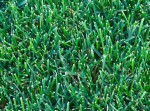 If you live in an area where 90o F temperatures in summer are rare you are probably going to be interested in growing cool-season grasses. They thrive in areas with warm short summers and cold winters where moisture is adequate. Their active growth is during the spring and fall when temperatures are between 60o and 75o F, and they grow more slowly as warm weather sets in, sometimes going dormant during long hot and dry periods. Cool weather grasses are sometimes used in the South to green up a lawn in the winter, and are used in the area between the North and South (a transition area) where they often struggle in summer heat.
If you live in an area where 90o F temperatures in summer are rare you are probably going to be interested in growing cool-season grasses. They thrive in areas with warm short summers and cold winters where moisture is adequate. Their active growth is during the spring and fall when temperatures are between 60o and 75o F, and they grow more slowly as warm weather sets in, sometimes going dormant during long hot and dry periods. Cool weather grasses are sometimes used in the South to green up a lawn in the winter, and are used in the area between the North and South (a transition area) where they often struggle in summer heat.
There are four major groups of cool weather grasses that are used for lawns; Kentucky bluegrass, fescues, ryegrass, and bent grass. There are different kinds of each with different characteristics that make them more or less desirable for various climates and situations. Detailed information on the best variety or cultivar of a specific grass for your particular part of the country is available from your local extension office.
All evaluations are given relative to the other cool-season grasses mentioned.
Kentucky bluegrass (Poa pratensis): The most commonly planted cool-season grass, Kentucky bluegrass’s dark green color and medium texture has made it popular for years. There are over 200 varieties, differing in disease resistance, shade tolerance, and hardiness.
-
Strengths: High tolerance to cold; some varieties resistant to disease.
Weaknesses: Intolerant of shade, drought, and heavy use; slow to establish
Fine Fescues: The group of grasses included chewings fescue, creeping red fescue, and hard fescue. All have a very fine texture and medium green color. They are usually sold in mixtures with Kentucky bluegrass.
 Chewings Fescue (Festuca rubra commutata)
Chewings Fescue (Festuca rubra commutata)
-
Strengths: Excellent shade and cold tolerance; good drought tolerance.
Weaknesses: Susceptible to fungal diseases in hot wet weather; develops thatch in acid soils; recovers slowly after being damaged; may go dormant in hot summer.
 Red fescue (Festuca rubra)
Red fescue (Festuca rubra)
-
Strengths: Drought, shade, and cold tolerant.
Weaknesses: Intolerant of wet soils and excess nitrogen; susceptible to fungal disease.
 Hard Fescue (Festuca longifolia)
Hard Fescue (Festuca longifolia)
-
Strengths: High drought, heat and shade tolerance; establishes well on infertile soil; some varieties disease resistant.
Weaknesses: Moderate wearability; slow recovery after damage.
 Tall Fescue (Festuca arundinacea)
Tall Fescue (Festuca arundinacea)
-
Strengths: Heat, drought, and shade tolerant; most tolerant of fescues to high traffic and hard use; good for transitional zones where warm-season and other cool-season grasses do poorly; some varieties pest resistant and disease resistant.
Weaknesses: Some varieties susceptible to brown patch during hot, wet conditions.
Ryegrasses: Both ryegrasses germinate and grow quickly.
 Annual Ryegrass (Lolium multiflorum): Usually used for temporary lawn or winter lawn in the South.
Annual Ryegrass (Lolium multiflorum): Usually used for temporary lawn or winter lawn in the South.
-
Strengths: Tolerates moderate traffic; can be planted when other grasses will not survive.
Weakness: Dies after one season
 Perennial Ryegrass (Lolium perenne):
Perennial Ryegrass (Lolium perenne):
-
Strengths: Tolerates high traffic; disease resistance.
Weaknesses: Low heat and cold tolerance.
Bent Grasses
 Creeping Bent Grass (Agrostis stolonifera):
Creeping Bent Grass (Agrostis stolonifera):
-
Strengths: Can be mowed very short for use in putting greens and similar uses.
Weakness: High maintenance; forms thick thatch; susceptible to pests and diseases; need extensive watering and fertilizing.
 Colonial Bent Grass (Agrostis tenuis):
Colonial Bent Grass (Agrostis tenuis):
-
Strengths: Similar to creeping bent grass but can not be mowed shorter and is less high maintenance.
Cool-season grasses are very attractive and have many virtues that make them desirable, They are usually not used alone but are incorporated into mixtures so that lawns benefit from the advantages of each. Check with your local nursery or extension agent to find out the best mix for your area.
